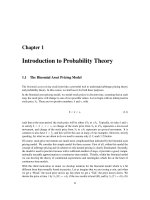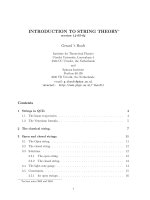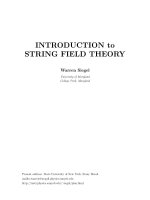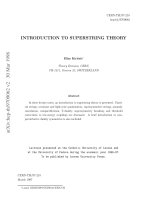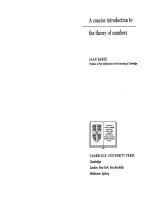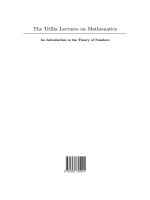- Trang chủ >>
- Khoa Học Tự Nhiên >>
- Vật lý
physics - introduction to string theory
Bạn đang xem bản rút gọn của tài liệu. Xem và tải ngay bản đầy đủ của tài liệu tại đây (421.39 KB, 83 trang )
Lecture 1
Quantum Field Theories: An
introduction
The string theory is a special case of a quantum field theory (QFT). Any QFT deals
with smooth maps of Riemannian manifolds, the dimension of is
the dimension of the theory. We also have an action function defined on the set
Map of smooth maps. A QFT studies integrals
Map
(1.1)
Here stands for some measure on the space of paths, is a parameter (usually
very small, Planck constant) and Map is an insertion function. The
number should be interpreted as the probability amplitude of the contribution
of the map to the integral. The integral
Map
(1.2)
is called the partition function of the theory. In a relativistic QFT, the space has a
Lorentzian metric of signature . The first coordinate is reserved for time,
the rest are for space. In this case, the integral (1.1) is replaced with
Map
(1.3)
Let us start with a -dimensional theory. In this case is a point, so is
a point and is a scalar function. The Minkowski partition function
of the theory is an integral
(1.4)
Following the Harvard lectures of C. Vafa in 1999, let us consider the following
example:
1
2
LECTURE 1. QUANTUM FIELD THEORIES: AN INTRODUCTION
Example 1.1. Recall the integral expression for the -function:
(1.5)
This integral is convergent for Re but can be meromorphically extended to the
whole plane with poles at . We have
By substituting in (1.5), we obtain the Gauss integral:
(1.6)
Although in the substitution above is a positive real number, one can show that
formula (1.6) make sense, as a Riemann integral, for any complex with Re .
When Re this is easy to see using the Hankel representation of as a
contour integral in the complex plane. When is a pure imaginary, it is more delicate
and we refer to [Kratzer-Franz], 1.6.1.2.
Taking , we can use
to define a probability measure on . It is called the Gaussian measure. Let us compute
the integral
Here We have
Obviously,
Also
3
where
is equal to the number of ways to arrange objects in pairs. This gives us
(1.7)
Observe that to arrange objects in pairs is the same as to make a labelled 3-valent
graph with vertices by connecting 1-valent vertices of the following disconnected
graph:
a
a
a
b
b
b
c
c
c
1
1
1
2
2
2
2n
2n
2n
Fig. 1
This graph comes with labeling of each vertex and an ordering of the three edges
emanating from the vertex. Let be such a graph, be the number of its vertices
and be the number of its edges. We have , so that
for some . Let
Then
where the sum is taken over the set of labeled trivalent graphs. Let be the number
of labelled trivalent graphs which define the same unlabelled graph when we forget
about the labelling. We can write , where is the number of
labelling of the same unlabelled 3-valent graph . Thus
where the sum is taken with respect to the set of all unlabelled 3-valent graphs. It is
easy to see that
Aut
4
LECTURE 1. QUANTUM FIELD THEORIES: AN INTRODUCTION
so that
Aut
Aut
Given an unlabelled 3-valent graph with vertices, we assign to each vertex a factor
, to each edge a factor , then multiply all the factors and divide by the
number of symmetries of the graph. This gives the Feynman rules to compute the
contribution of this graph to the coefficient at . For example, the graph
contributes and the graph
contributes The total coefficient at is . This
coincides with the coefficient at in given by the formula (1.7).
Recall that the Principle of Stationary Phase says that the main contributions to the
integral
when goes to infinity comes from integrating over the union of small comapct neigh-
borhoods of critical points of . More precisely we have the following lemma:
Lemma 1.1. Assume has a compact support and has no critical points
on . Then, for any natural number ,
Proof. We use induction on . The assertion is obvious for . Integrating by parts,
we get
Multiplying both sides by , we get
Applying the induction to the function we get the assertion.
5
Thus if has finitely many critical points , we write our function
as a sum of functions with support on a compact neighborhood of
and a function which has no critical points on the support of and obtain, for
any ,
Now let us consider a QFT in dimension 1. Usually we write , where
is the space-dimension, and is the time-dimension. A QFT in dimension is the
quantum mechanics. In this case, we take to be equal to , or
parametrized by . A map is path in (infinite, or finite, or a loop). The
action is defined by
where is a smooth function defined on the tangent space of (a La-
grangian). The expression is a density on equal to the composition
of the differential and .
For example, take so that with coordinates . For
any and a map , is obtained by replacing with
and with .
A critical point of the functional satisfies the Euler-Lagrange equation
(1.8)
For example, let us take the Lagrangian
(1.9)
Then we get from (1.8)
Thus a critical path satisfies the Newton Law; it gives the major contribution to the
partition function.
Fix and . Let be the space of smooth maps
such that . The integral
(1.10)
can be interpreted as the “probability amplitude” that a particle in the position at the
moment of time moves to the position at the time .
6
LECTURE 1. QUANTUM FIELD THEORIES: AN INTRODUCTION
Let us compute it for the action defined by the Lagrangian (1.9) with . We
shall assume that the potential function is equal to zero.
The space is of course infinite-dimensional and the integration over
such a space has to be defined. Let us first restrict ourselves to some special finite-
dimensional subspaces of . Fix a positive integer and subdivide the
time interval into equal parts of length by inserting inter-
mediate points . Let us choose some points
in and consider the path such that
its restriction to each interval is the linear function
It is clear that the set of such paths is bijective with and so we can integrate
a function over this space to get a number . Now we can
define (1.10) as the limit of integrals when goes to infinity. However, this limit
may not exist. One of the reasons could be that contains a factor for some
constant with . Then we can get the limit by redefining , replacing it
with . This really means that we redefine the standard measure on
replacing the measure on by . This is exactly what we are going to
do. Also, when we restrict the functional to the finite-dimensional space of
piecewise linear paths, we shall allow ourselves to replace the integral by
its Riemann sum. The result of this approximation is by definition the right-hand side
in (1.10). We should immediately warn the reader that the described method of giving
a value to the path integral is not the only possible.
We have
(1.11)
Here are vectors in and is the standard measure in . The number
should be chosen to guarantee convergence in (1.11). Using (1.6) we have
Next
7
Thus
Continuing in this way, we find
where If we choose the constant equal to then we will
be able to rewrite (1.11) in the form
(1.12)
We shall use to define a certain Hermitian operator in the Hilbert
space . Recall that for any manifold with some Lebesgue measure the
space consists of square integrable complex valued functions modulo func-
tions equal to zero on the complement of a measure zero set. The hermitian inner
product is defined by
Example 1.2. An example of an operator in is a Hilbert-Schmidt operator:
where is the kernel of . In this formula we integrate
keeping fixed. By Fubini’s theorem, for almost all , the function
is -integrable. This implies that is well-defined. Using the Cauchy-Schwarz
inequality, one can easily checks that
8
LECTURE 1. QUANTUM FIELD THEORIES: AN INTRODUCTION
i.e., is bounded, and
We have
This shows that the Hilbert-Schmidt operator is self-adjoint if and only if
outside a subset of measure zero in .
In quantum mechanics one often deals with unbounded operators which are defined
only on a dense subspace of a complete separable Hilbert space . So let us extend
the notion of a linear operator by admitting linear maps where is a dense
linear subspace of (note the analogy with rational maps in algebraic geometry). For
such operators we can define the adjoint operator as follows. Let denote the
domain of definition of . The adjoint operator will be defined on the set
Take . Since is dense in the linear functional
extends to a unique bounded linear functional on . Thus there exists a unique vector
such that . We take for the value of at . Note that
is not necessary dense in . We say that is self-adjoint if
and . We shall always assume that cannot be extended to a linear operator on
a larger set than . Notice that cannot be bounded on since otherwise we
can extend it to the whole by continuity. On the other hand, a self-adjoint operator
is always bounded. For this reason self-adjoint linear operators with
are called unbounded linear operators.
Example 1.3. Let us consider the space and define the operator
Obviously it is defined on the space of differentiable functions with square integrable
derivative. This space contains the subspace of smooth functions with compact support
which is known to be dense in . Let us show that the operator is
self-adjoint. Let . Since ,
9
is defined for all . Letting go to , we see that exists. Since
is integrable over , this implies that this limit is equal to zero. Now, for any
, we have
This shows that and is equal to on . The proof that
is more subtle and we omit it.
Let
be two copies of the space . Let be the Hilbert-Schmidt
operator defined by a kernel which has as real parameters:
Suppose our kernel has the following properties:
(M)
(N)
(T)
if
(C) for any , the function
is continuous for and
When is defined by the path integral, property (M) is taken as one of the axioms of
QFT. It expresses the property that any path from to is equal to
a sum of paths from to and a path from to
. Property (N) says that the total probability amplitude of a particle to move from
to somewhere is equal to 1. Notice that property (N) implies that the operator is
unitary. In fact,
10
LECTURE 1. QUANTUM FIELD THEORIES: AN INTRODUCTION
Now we use the following Stone-von Neumann’s Theorem:
Theorem 1.1. Let be a family of unitary operators in a Hilbert space
. Assume that
(i) for all , the function is continious for and
;
(ii) for all
Then
exists
is dense in and the operator defined by
is self-adjoint. It satisfies
Applying this to our situation, we obtain that
for some linear operator . The operator is called the Hamiltonian operator asso-
ciated to .
We would like to apply the above to our function
Unfortunately we cannot take the function to be the kernel of a Hilbert-
Schmidt operator. Indeed, it does not belong to the space . In particular
property (N) is not satisfied. One can show that (M) is OK, (T) is obviously true and
(C) is true if one restricts to functions from a certain dense subspace of .
The way about this is as follows (see [Rauch]).
First let us recall the notion of the Fourier transform in . It is a linear operator
defined on the Schwartz space of smooth functions with all derivatives
tend to zero faster than any power of as . It is given by the formula
Here are some of the properties of this operator:
11
(i) is an unitary operator;
(ii) ;
(iii) ;
(iv)
(v) , where
Let us show that our function is the propagator for the Schr
¨
odinger equa-
tion
We take for simplicity . Supose . Let us find the solution in
using the Fourier transform. Using property (iii), we get (we
use the Fourier transform only in the variable ). Integrating this equation with initial
condition , we get
Taking the inverse Fourier transform, we get
(1.13)
Clearly, Of course, we have still to show the existence
of a solution. We skip the check that formula (1.13) gives a solution in . This
defines us a linear operator (the propagator)
We would like to show that it is an integral operator and find its kernel. Let
. Then
Unfortunately, this computation is wrong since the function does not belong
to . A way about it is to consider this function as a distribution and extend the
Forier transform to distributions.
12
LECTURE 1. QUANTUM FIELD THEORIES: AN INTRODUCTION
Recall that a distribution is a continuous linear functional on the space of
smooth functions with compact support (test functions). Any function which can be
integrated over any finite closed interval (but not necessary over the whole ) can be
considered as a distribution. Its value at a test function is equal to
where the bar denotes the complex conjugation. Such a distribution is called a regular
distribution or a tempered distribution. The rest are called singular distributions. We
shall denote the value of a distribution on a test function by
If is a regular distribution defined by a function from , then
An example of a singular distribution is the delta-function whose value at a test
function is equal to . It is also denoted by . A linear operator
with extends to the space of distributions by the formula
If , viewed as a regular distribution, we have
so the two definitions agree.
For example let be defined on the space of functions with square integrable
derivative. We have
and for any distribution , . If is a
tempered distribution defined by an integrable differential function such that also
defines a tempered distribution, then the formula of integration by parts shows that this
definition agrees with the usual definition of derivative.
Since the Fourier transform is an example of an operator defined on with
, we can define the Fourier transform of a distribution by
All the properties (i)-(v) extend to distributions. In property (v) we define the convolu-
tion of a regular distribution and an element of by the formula
Lemma 1.2. For any with Re ,
13
Proof. Assume first that Re . Then the function belongs to and,
using the Gaussian integral, we obtain
Therefore, for any ,
Consider the both sides as functions of . When Re each side is a holo-
morphic function, and, for Re , are continuous functions. The unique
continuation principle for holomorphic functions implies that the two sides are equal
for Re . This proves the lemma.
Now we can use the lemma to set
Property (v) of Fourier transform gives us
Thus we see that the integral operator with the kernel
is well-defined as an operator on the space . Now observe that
This shows that is a unitary operator. In particular, is bounded on (of
norm 1) and hence continuous. It is known that is dense in . Thus we can
14
LECTURE 1. QUANTUM FIELD THEORIES: AN INTRODUCTION
extend by continuity to an unitary operator on the whole space . It satisfies
the property
Using property (iii) we get
where This justifies the claim that is the kernel of the operator
on .
Finally let us try to justify the following formula from physics books:
(1.14)
First of all for any from a Hilbert space , physicists employ the bra-ket notation
If is a linear operator in , then
Let be a normalized eigenfunction of an operator with an eigenvalue . Physicists
denote it by (although it is defined only up to a factor of absolute value one). To
simplify the notation they set
Consider an operator (the position operator)
It is a self-adjoint operator . Its eigenfunctions do not belong to the
space but rather to the space of distributions.
We have
Thus can be considered as an eigendistribution of with eigenvalue . Thus for any
we have, according to physicist’s notation, . Now we have to compute
. Recall that we can view it as an integral operator with kernel
defined on the Schwartz space which obviously contains . We have
15
Taking we get formula (1.14). We have to understand it as
For any function and a point one can consider a function on the
set Map defined by
Let be functions on and , one can consider the integral
Map
The right-hand side is called the path integral with insertion functions . The
left-hand-side is called the correlation -function. In the example above
Exercises
1.1 Find the Feynman rules to compute
Compute the coefficient at .
1.2 Show that the distribution (defined to be zero for )
is a generalized solution of the equation
(you have to give the meaning of the right-hand-side).
1.3 Show that, for any , the function is a generalized eigenfunction of the
operator in and any generalized eigenfunction coincides with one of these
functions.
1.4 Find the Fourier transform and the derivative of the Dirac function .
16
LECTURE 1. QUANTUM FIELD THEORIES: AN INTRODUCTION
Lecture 2
Partition function as the trace of
an operator
Recall that the trace Tr of an operator in a finite dimensional Hilbert space is
equal to the sum of the diagonal entries of a matrix of with respect to any basis. If
we choose an orthonormal basis , then
Tr (2.1)
If is a normal operator (e.g. Hermitian or unitary), then one can choose an orthonor-
mal basis of consisting of eigenvectors of . In this case
Tr
Sp
(2.2)
where Sp is the spectrum of (the set of eigenvalues) and is equal to the
dimension of the eigensubspace corresponding to the eigenvalue . Notice that
Sp
This gives
Tr (2.3)
There are several approaches to generalize thenotion of the trace to operators in infinite-
dimensional Hilbert spaces. We shall briefly discuss them. First assume that is a
bounded operator. First we try to generalize the definition of a trace by using (2.1).
One chooses a basis and sets
Tr
17
18
LECTURE 2. PARTITION FUNCTION AS THE TRACE OF AN OPERATOR
if the series convergent. If the convergence is absolute, then this definition does not
depend on the choice of a basis. In this case is called a trace-class operator. For
example, one can show that Tr Tr if both and are trace-class. An
example of a trace-class operator is a Hilbert-Schmidt operator in the space .
If is its kernel, then
Tr
When is a self-adjoint Hilbert-Schmidt operator, the two definitions coincide. This
follows from the Hilbert-Schmidt Theorem.
Example 2.1. Let be a finite set equipped with the measure
. Then with inner product
where . It is clear that can be identified
with a matrix and
so that is a linear operator defined by the matrix . Then its trace is equal to
Tr
This agrees with definition (2.1) when we take the standard orthonormal basis of .
As we have already mentioned, in physics one deals with unbounded linear opera-
tors in like a differential operator. One tries to generalize definition (2.3).
Notice that
Now for any such that has a basis of eigenvectors of one can define the
zeta-function of as follows. Let be the sequence of
positive eigenvalues of . One sets
where is the multiplicity of , i.e. the dimension of the eigensubspace of eigen-
vectors with eigenvalue . When , where is a compact manifold
of dimension and is a positive elliptic differential operator of order , one can show
19
that is an analytic function for Re and it can be analytically extended
to an open subset containing . In this case we define
This obviously agrees with (2.3) when is finite-dimensional. Also it is easy to see
that for any positive number
(2.4)
This of course agrees with the finite-dimensional case because .
Example 2.2. Consider the operator which acts on the space , where
with the usual measure descended to the factor. Note that in this
measure the length of is equal to , i.e. is the circle of radius . The measure
corresponds to the choice of metric on the circle determined by its radius. The
normalized eigenvectors of are . The positive part of the spectrum
consists of numbers with . Thus
where is the Riemann zeta function. It is known to be an analytic function for
Re . This agrees with the above since is one-dimensional and is an
elliptic operator of second order. We have
Thus
and
det (2.5)
Example 2.3. Let us consider the path integral when and .
We use the action
A map extends to a map of the universal coverings . It satisfies
for some integer (equal to the degree of the map of
oriented manifolds). Let Map be the set of maps corresponding to the same .
It is clear that each Map can be uniquely written in the form
20
LECTURE 2. PARTITION FUNCTION AS THE TRACE OF AN OPERATOR
where satisfies , hence belongs to . The value of
on such is equal to
We have
Thus
The Minkowski partition function is
Map Map
Observe that we must have
Map
where
to be consistent with the previous computation of the path integral.
This gives
Now we apply the Poisson summation formula
Taking , we get
(2.6)
Let us compute the trace of the operator . Its normalized
eigenfunctions in are the functions . By (2.1), we have
Tr
21
Comparing this with (2.6), we see that
Tr
where .
Remark 2.1. If we repeat the computations for the Euclidean partition function (replac-
ing with ) we get
This shows that
If we modify the partition function by inserting the factor , we get
This is the first glimpse of the T-duality.
Let
be the modular form associated to the quadratic form ( equal to the value at
zero of the Riemann theta function in one variable). It satisfies the functional equation
(the proof uses the Poisson summation formula). Observe that
This is our first encounter with the theory of modular forms.
There is another way to compute the partition function for the action
Map
where is the circle of radius . Notice that
Thus
Map
22
LECTURE 2. PARTITION FUNCTION AS THE TRACE OF AN OPERATOR
where . The integral
can be thought as a generalization of the Gaussian integral since is a
quadratic form in . If and is a positive-definite self-adjoint
operator, we could use the orthogonal change of variables to diagonalize and write
Here we assumed that all eigenvalues are positive, or equivalently, that the quadratic
form is positive definite. To get rid of let us change the measure on
replacing with so that
Now, for any normal positive definite operator in a Hilbert space , we
can write any element as a sum , where is an orthonormal basis
of eigenvectors of . The coordinate is an analog of the coordinate from above.
This motivates the following definition
det (2.7)
Here the measure is defined up to some multiplicative constant . In fact we will
be defining the correlation functions by the formula
so the choice of the constant will not matter. We would like to appy this to the op-
erator in . However, not all of its eigenvalues are positive.
Constant functions form the nullspace of this operator. If we decompose each vector
as a sum of normalized eigenvectors, then coefficients will be analogs
of the coordinates in . So, we can write our space as the product of the space of
constant functions and functions with . The coefficient of the constant function
at is equal to . Thus the integral over the space of constant
functions is equal to So, using (2.5), we obtain
23
This agrees with the computations in example 2.3 if we switch from the Minkowski
partition function to the Euclidean one.
Here is another application of the Gaussian integral for quadratic functionals. Con-
sider the action functional defined by some Lagrangian . We know
that its stationary points are classical solutions. Write , where
is a classical solution. Then
terms of higher order in
This gives a semi-classical approximation:
classical solutions
This approximation is exact when the action is quadratic in .
Example 2.4. We take and . The Lagrangian is
and the Minkowski partition function is
It is called the path integral of the harmonic oscillator. The kernel of the operator
is given by
Choose a critical path
cl
for the action defined by our Lagrangian and decompose
the action in the Taylor expansion at
cl
.
cl
cl
cl
(2.8)
The classical path is a solution of the Lagrangian equation:
Its solution satisfying the initial condition is
cl
24
LECTURE 2. PARTITION FUNCTION AS THE TRACE OF AN OPERATOR
The value of the action functional on the classical solution is
cl cl cl
The second variation of the action functional is
Thus we can rewrite (2.8) in the form
cl
cl cl
Now let us make the variable change replacing
cl
with . The limits in the
path integral change to . The paths we integrate over are periodic
with the period satisfying . Using the generalization of
the Gaussian integral to functional integrals we have
Map
where
The eigenfunctions of satisfying the condition are the functions
, where and . The corresponding eigenvalues are
equal to . We know that
Of course here we use a “physicists’s argument” since we don’t have the right to write
the product as the product of two infinite products , one of which is divergent (see
the next remark for an attempt to justify the argument). Now we use that the first
product corresponds to the action with . So to be consistent with our previous
computation we must have
25
Note that if we compute the product using the zeta function of the operator
on the sapce of functions on satisfying we get
The two computations disagree. The way out of this contradiction is the choice of the
normalizing constant which we used to define the Gaussian integral. It shows that
we have to choose . Now we use the Euler infinite product expansion for the
sine function:
From this we deduce that
cl
cl cl
Let us rewrite
cl
in the following form
cl
Using this we obtain
